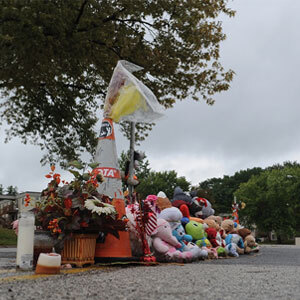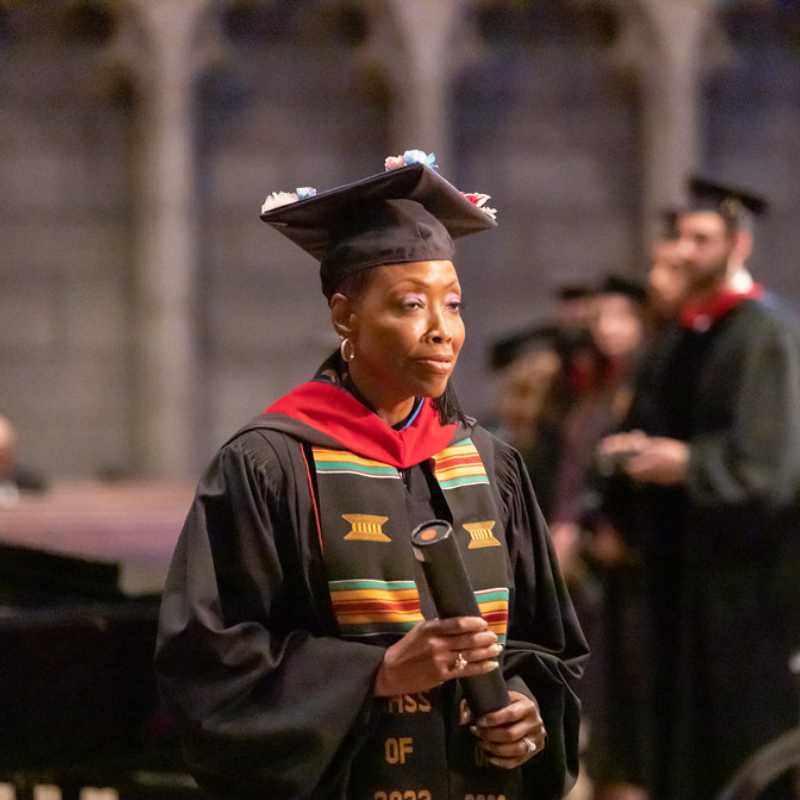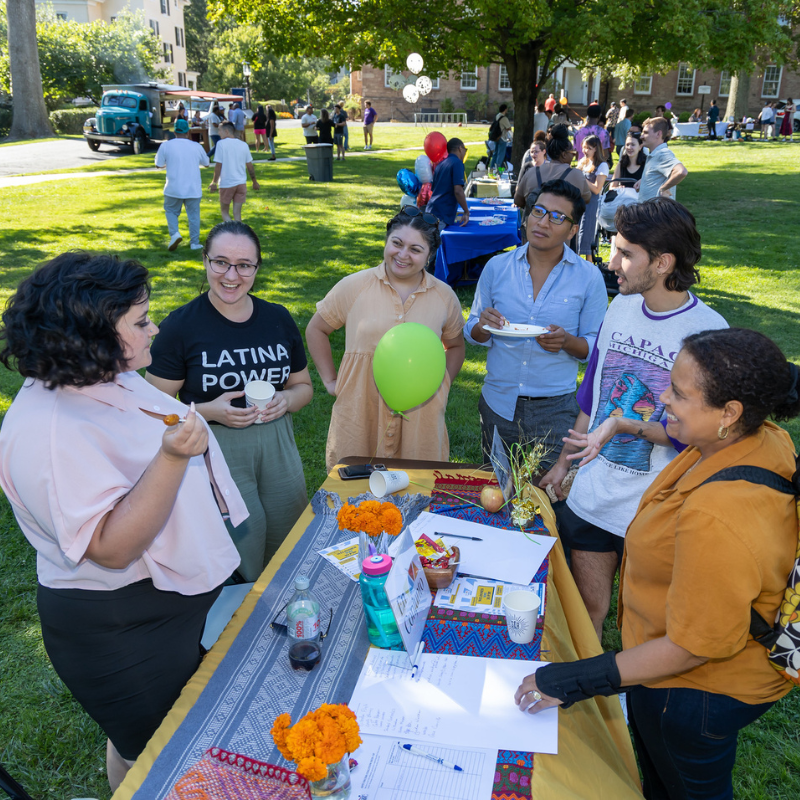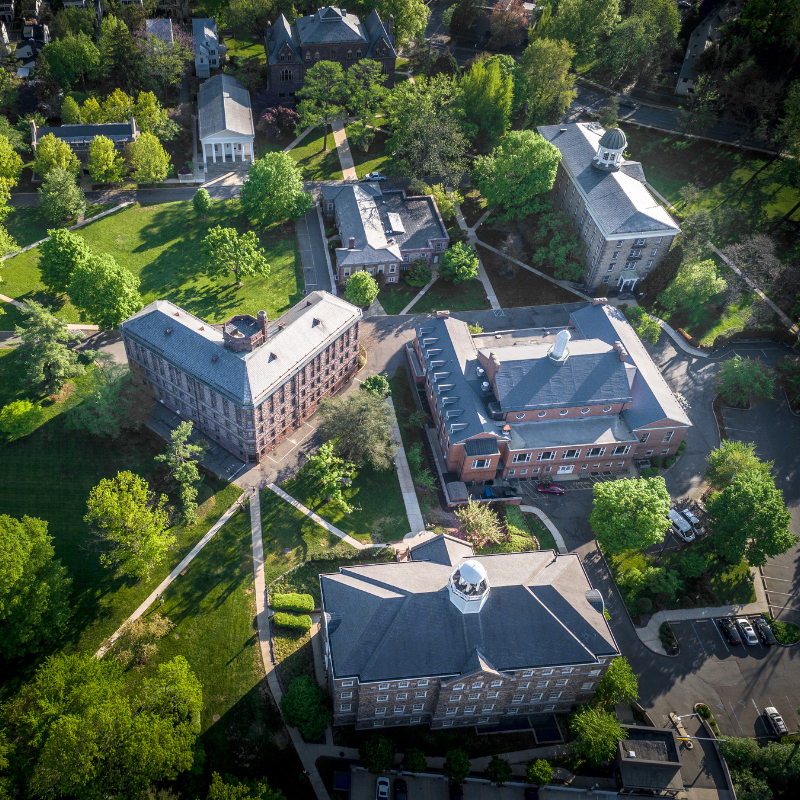Bearing Witness in Ferguson
August 30, 2022 | Alumni, Betsey Stockton Center for Black Church Studies, Black Lives Matter, Featured, Public

Darnell Moore couldn’t sleep.
Hours earlier on that August day in 2014, a Black teenager, Michael Brown Jr., was shot and killed by a white police officer in Ferguson, Missouri.
Moore, a Princeton Theological Seminary alumnus living in Brooklyn, knew he needed to act.
“I texted a friend and said, ‘We need to go to Ferguson,’” says Moore. “It felt like there had been this genealogy of Black deaths that began with Trayvon Martin, and this was a boiling point.”
Moore, MA(TS) ’07, began working with Black Lives Matter co-founder Patrice Cullors on what would be called the Freedom Ride to Ferguson. He wasn’t the only Seminary alum to ride. After several frenetic weeks of organizing, Moore and six other alums boarded a packed chartered bus in Manhattan to make the 20-hour ride to Ferguson where they would join hundreds of others for what would be a historic Labor Day weekend in 2014.
They participated in rallies, held teach-ins, and made pilgrimages to the Canfield Drive site where the 18-year-old Brown had been killed. They listened to the stories of Ferguson residents and learned organizing strategies from seasoned activists.
They also felt a palpable sense of danger from police in riot gear and others in Ferguson who opposed their presence.
“At times it felt like the state was at war against the people,” says Teddy Reeves, MDiv ’13. “You’d be driving past where Mike Brown’s body had been laying in the street and the buildings are boarded up like a war zone.”
The impact of that Freedom Ride contributed to Black Lives Matter’s growth from a hashtag to a global movement and the rallying cry for the racial reckoning that took hold in 2020.
It was also a turning point in the lives of the alums, most of whom were still working out how they would carry their Seminary education into the world. The trauma, pain, and hope they bore witness to in Ferguson helped them find their own callings and shaped their approach to ministry, often in roles outside the church.
“Ferguson proved to be more than just a fight for justice, but a birth of a new spiritual reality for me and others,” Reeves wrote in his 2020 dissertation at Fordham University. He is now a curator of religion at the Smithsonian National Museum of African American History and Culture.
Regina Langley, PhD ’15, MDiv ’00, was immersed in her doctoral studies when she went to Ferguson. Her experience there included an extraordinary encounter with Ferguson women that influenced her work for years to come.
Her work in congregational ministry, life coaching, and independent research has taken her across the globe to address violence against women, homelessness, substance abuse, and social injustice.
“That experience in Ferguson impressed on me the importance of allowing people to tell their own stories, even if they make others uncomfortable,” Langley says.
Nyle Fort, MDiv ’14, would later enroll in Princeton University, where his doctoral work on religion, interdisciplinary humanities and African American studies was profoundly influenced by what he saw in Ferguson. He too devoted part of his dissertation to the experience.
“I wrote on how grief and mourning mobilized and animated the Black protests and politics that became central to the Ferguson uprising and to the movement for Black life,” says Fort, who recently accepted a faculty position at Columbia University.
Moore went on to write an acclaimed memoir, No Ashes in the Fire, and hold numerous social justice roles before moving into his current position as vice president of inclusion strategy at Netflix.
“Organizing is righteous work,” Moore says. “But I found my role using media and culture as a sort of microphone to move people along.”
Other alums who participated include Damien Conners, MDiv ’09; Azsherae Gary, MDiv ’14; and Taylor Gordon, MA ’14.
“In that moment, I understood what ministry was”
Black Lives Matter was begun as a hashtag by three organizers — Cullors, Alicia Garza, and Opal Tometi — in response to the 2013 acquittal of George Zimmerman in the killing of Trayvon Martin.
When the Ferguson uprising began the following year, the movement was ready. Moore and Cullors launched an organizing effort that helped bring around 600 people from around the country to Ferguson.
“The ride had a real particular importance because it brought bodies to a central place,” Moore says. “The purpose was to support the Ferguson people and then bring that energy back to our own Fergusons.”
Langley was working on her dissertation, studying how Black women show up in spaces not reserved for them, including the investigative journalist Ida B. Wells, who had exposed the horror of lynching. Appalled by the news that Brown’s body had remained in the street for four and a half hours, Langley saw a shocking parallel to the period of the 19th and early 20th century that was the subject of her research at Princeton Seminary.
“It sounded like a modern-day lynching,” Langley says. “I wanted to see with my own eyes what Ida B. Wells had written about.”
After the group arrived in Ferguson, Langley set out to learn more from residents. She met several women gathered near where Brown had been killed. After getting acquainted, she interviewed them, documenting the conversations on her camcorder. The women spoke of seeing Brown’s body, and the difficult emotions they had been carrying around silently over the previous weeks.
Soon they were all in tears.
“Nobody had given them the platform to talk about the sorrow and grief they were feeling,” Langley says. “The African American community is a very connected community, and so even though Mike Brown was someone else’s child, he was the community’s child.”
“Everybody was experiencing the trauma, and in that moment, I understood what ministry was.”
“The sacred and secular were connecting”
At the site where Brown was killed along the center of Canfield Drive, residents had set up a street memorial that included candles, teddy bears, protest signs, and a St. Louis Cardinals cap.
Fort says he and other Freedom Riders were transfixed by this display of love and grief.
“It was a deeply spiritual experience where the sacred and the secular were connecting,” he says. “We were protesting police violence, but we were also honoring the life of Michael Brown, and there was this beloved community that took form and had a certain shape and texture different from the protests.”
Reeves too felt transformed by what he saw in Ferguson. Drawn initially by the historic connection to the 1960s civil rights movement, he felt he was witnessing the emergence of something wholly new as he attended rallies and teach-ins. Black Lives Matter, he noted, was led by women and welcoming to the LGBTQ community and people of all ages. Some were religious. Many were not. Poets, hip-hop artists, and even a few Wiccans were in the crowd, he says.
“It was grassroots organizers and activists coming together for Black life,” Reeves says. “As a theologian and as a practitioner, that for me was in line with the God and the Jesus I follow, and it was transforming.”
On Saturday, Aug. 31, the Freedom Ride participants along with scores of others marched to the Ferguson police station, facing police officers who were lined up to form a barricade. And in that moment, Reeves felt that everything he learned in Seminary was being put into practice under dangerous circumstances.
“I remember thinking, ‘Am I okay with it all ending here, for the sake of justice, not only for Mike Brown, but for Black folk all over?’’ he says. “And I was okay with that. I think that was a peace many folks made in that space.”
When the weekend ended, participants went home and formed Black Lives Matters chapters in 18 cities, and soon the movement developed the infrastructure for its global network.
Reflecting on that weekend, the Princeton Seminary alums acknowledged the struggle for racial justice is hardly over. But they said Ferguson was the beginning of something new, and enduring. They could see that in the global response to the killings of George Floyd, Breonna Taylor, and other Black Americans in 2020. And they said the decentralized approach of Black Lives Matter, which seeks to bring the marginalized voices of women and LGBTQ people into leadership roles, is empowering in ways that earlier movements were not.
“I knew that we had crossed into a new state of reckoning with racial injustice,” Moore says. “I knew in a moment this is a collective that is making history and herstory.”





